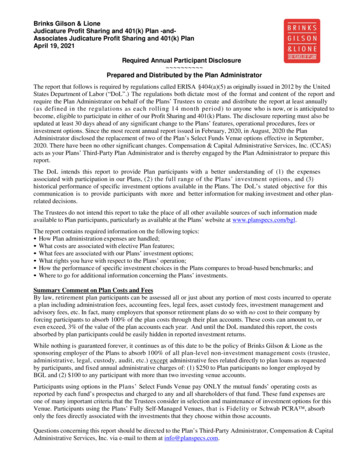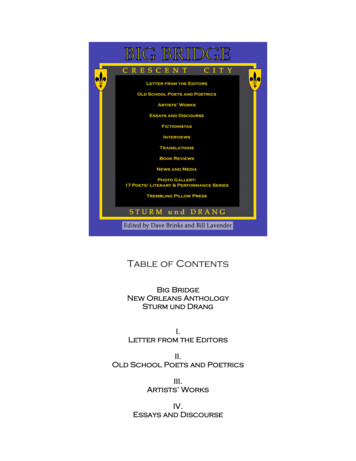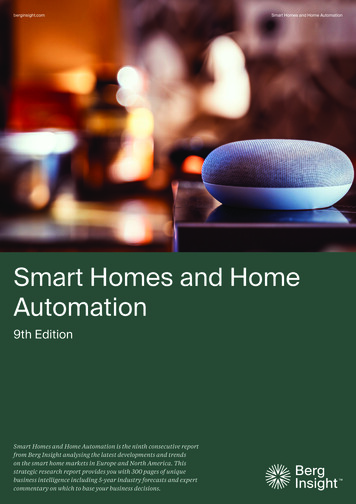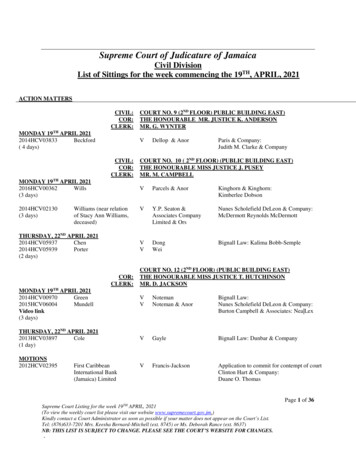
Transcription
Brinks Gilson & LioneJudicature Profit Sharing and 401(k) Plan -andAssociates Judicature Profit Sharing and 401(k) PlanApril 19, 2021Required Annual Participant Disclosure Prepared and Distributed by the Plan AdministratorThe report that follows is required by regulations called ERISA §404(a)(5) as originally issued in 2012 by the UnitedStates Department of Labor (“DoL”.) The regulations both dictate most of the format and content of the report andrequire the Plan Administrator on behalf of the Plans’ Trustees to create and distribute the report at least annually(as defined in the regulations as each rolling 14 month period) to anyone who is now, or is anticipated tobecome, eligible to participate in either of our Profit Sharing and 401(k) Plans. The disclosure reporting must also beupdated at least 30 days ahead of any significant change to the Plans’ features, operational procedures, fees orinvestment options. Since the most recent annual report issued in February, 2020, in August, 2020 the PlanAdministrator disclosed the replacement of two of the Plan’s Select Funds Venue options effective in September,2020. There have been no other significant changes. Compensation & Capital Administrative Services, Inc. (CCAS)acts as your Plans’ Third-Party Plan Administrator and is thereby engaged by the Plan Administrator to prepare thisreport.The DoL intends this report to provide Plan participants with a better understanding of (1) the expensesassociated with participation in our Plans, (2) the full range of the Plans’ investment options, and (3)historical performance of specific investment options available in the Plans. The DoL’s stated objective for thiscommunication is to provide participants with more and better information for making investment and other planrelated decisions.The Trustees do not intend this report to take the place of all other available sources of such information madeavailable to Plan participants, particularly as available at the Plans’ website at www.planspecs.com/bgl.The report contains required information on the following topics: How Plan administration expenses are handled; What costs are associated with elective Plan features; What fees are associated with our Plans’ investment options; What rights you have with respect to the Plans’ operation; How the performance of specific investment choices in the Plans compares to broad-based benchmarks; and Where to go for additional information concerning the Plans’ investments.Summary Comment on Plan Costs and FeesBy law, retirement plan participants can be assessed all or just about any portion of most costs incurred to operatea plan including administration fees, accounting fees, legal fees, asset custody fees, investment management andadvisory fees, etc. In fact, many employers that sponsor retirement plans do so with no cost to their company byforcing participants to absorb 100% of the plan costs through their plan accounts. These costs can amount to, oreven exceed, 3% of the value of the plan accounts each year. And until the DoL mandated this report, the costsabsorbed by plan participants could be easily hidden in reported investment returns.While nothing is guaranteed forever, it continues as of this date to be the policy of Brinks Gilson & Lione as thesponsoring employer of the Plans to absorb 100% of all plan-level non-investment management costs (trustee,administrative, legal, custody, audit, etc.) except administrative fees related directly to plan loans as requestedby participants, and fixed annual administrative charges of: (1) 250 to Plan participants no longer employed byBGL and (2) 100 to any participant with more than two investing venue accounts.Participants using options in the Plans’ Select Funds Venue pay ONLY the mutual funds’ operating costs asreported by each fund’s prospectus and charged to any and all shareholders of that fund. These fund expenses areone of many important criteria that the Trustees consider in selection and maintenance of investment options for thisVenue. Participants using the Plans’ Fully Self-Managed Venues, that is Fidelity or Schwab PCRA , absorbonly the fees directly associated with the investments that they choose within those accounts.Questions concerning this report should be directed to the Plan’s Third-Party Administrator, Compensation & CapitalAdministrative Services, Inc. via e-mail to them at info@planspecs.com.
Brinks Gilson & Lione Judicature and Associates Judicature Profit Sharing and 401(k) PlansDepartment of Labor-required Annual Participant Disclosures Report – April 19, 2021Report Page 1This U.S. Department of Labor (DoL)-required report contains important information concerning our Plans. Itsintroductory first section provides general information about the Plans’ investing structure including expensesyou might incur through participation in the Plans or upon exercising various Plan rights and features. Thesecond section provides information about risks inherent in any investing process and points you to internetbased sources of additional information to help you learn more about investing. The third section focuses oninformation specific to the Plans’ [non-Fully Self-Directed] investment alternatives in our Select Funds Venueincluding historical performance, any fees or expenses associated with those investments, and industry-basedcomparisons thereof for quick reference.If you have questions concerning any of this information or would like to request further information regardinganything associated with this report, contact the Plans’ Third-Party Plan Administrators (their “TPA”) atinfo@planspecs.com. Plan-specific information available in this report or elsewhere in the public domainincludes annual operating expenses of the Plans’ investments; prospectuses, financial statements, reports, orother materials relating to investments available in the Plans; a list of assets contained in each Plan’sinvestment menu; the value of those assets and fund units or shares; and the past and current performance ofeach Plan investment as compared to appropriate broad based market indices. The Plans’ website atwww.planspecs.com/bgl contains comprehensive and focused materials specific relevance to the Plans’operations and available investments. You may also view the Plans’ Summary Plan Description on the website.Section I: Explanation of the Plan’s Investments Structure and Plan ExpensesPlan Investment StructureThe Plans are intended to be in compliance with regulations under ERISA §404(c). In short, this simply meansthat every participant must "exercise control" over direction of all the investments in their Plan account and thePlans’ fiduciaries must provide all participants with an appropriately diverse and high-quality set of investmentalternatives as well as relevant information by which to do so. As a result of this regulatory compliance, thePlans’ fiduciaries are legally relieved of liability, or responsibility, for any losses that a participant mayexperience as a direct result of the participant’s investment decisions. Participants provide the TPA (or Fidelityor Schwab) with investment directions for their Plan account, selecting from investment choices provided underour Plans as ultimately determined by its Trustees: Dave Fleming, Janet Pioli, Lee Rendino and Marc Richards.The Plans’ three Investment Venues are: The Designated Investment Alternatives (“DIA”) Select Funds Venue,and the Fully Self-Directed (“FSD”) Venue’s Fidelity Brokerage and Schwab PCRA Brokerage accounts. ThePlans allow your participation in one, two or three of these investment venues and your change of investmentvenue choice at fixed monthly venue transfer dates. DIA Venue fund directives specific to existing balancestherein may also be changed at your discretion monthly effective at the fixed monthly transfer date. Changes toand limitations on investments chosen by a participant within all investment venues are imposed by the Trusteesand stipulated in the Plan documents and notes contained on the Plans’ administrative forms. Changes to andlimitations on investments purchased by a participant within the FSD Venue are additionally regulated by theFSD Venue account custodians themselves (that is, Fidelity and Schwab) and also by the underlyinginvestments you select within those FSD accounts.The Plans’ Trustees maintain authority to exercise certain voting, tender or similar rights as applicable toinvestments held in the Plans’ DIA Venue. The Plans allow participants to exercise certain voting, tender orsimilar rights as applicable to investments held in an FSD Venue account.Plan Costs and FeesThe development and maintenance of 401(k) and profit sharing retirement plans require someone to bear manydifferent types of costs. In general these can be categorized into Administrative and Investment-Related costs.Administrative Costs: These include costs of administration, legal, asset custody, trustee, accounting services,independent auditor and, in our Plans, independent investment advisory to the Trustees related to the DIAVenue’s investment options. BGL shoulders all of these non-investment management costs except the followingparticipant fees to offset the full costs of: (a) the administration of Plan loans ( 100 at initiation for new loans,th 150 for initiation of refinances and 50 annually per loan outstanding on Dec 15 ), (b) the administration ofthPlan accounts for participants no longer employed by BGL ( 250 annually on Dec 15 for employmentth)terminations prior to that year’s Oct 15 , (c) the administration of Plan accounts for any participant with moreththan two investing venue accounts on Dec 15 ( 100 annually flat fee), and (d) requests for proceeds ofdistributions or loans by Fed Wire ( 20 per occurrence) as opposed to free-of-charge disbursements by check.
Brinks Gilson & Lione Judicature and Associates Judicature Profit Sharing and 401(k) PlansDepartment of Labor-required Annual Participant Disclosures Report – April 19, 2021Report Page 2Investment-related Costs: Your Plans authorize investment product providers such as DIA mutual funds, FidelityInvestments and Charles Schwab & Co to charge appropriate, pre-determined and published transaction andinvestment-related expenses against your account. The level, purpose and basis for such expenses are directlyrelated to each investing venue and specific investments within the venue(s) you choose for your Plan account.DIA Venue: Participants in the Plans’ DIA Select Funds Venue mutual funds are responsible only for eachfund’s prospectus-published operating expenses as charged to any and all shareholders of that fund. ThePlan allocates no other investment-related fees against participant accounts in the DIA Venue. Furthermore,as a result of the judicious selection of mutual funds for this Venue by the Trustees as counseled by the SEC(Securities and Exchange Commission) – Registered Investment Advisory firm of Investment Consultants, theSelect Funds Venue’s mutual funds provide investment management at significantly below-industry-averagelevels. Table 1 of this report illustrates the significance of this very favorable cost structure.These prospectus-published fees are further reduced by rebates paid to the Plans’ Trust by six of your currentSelect Funds Venue’s fourteen DIA’s. These fee rebates range from 0.15% to 0.25% (of the Plans’ averagedaily balance in each of these funds) per year. In general, many funds offer fee rebates to retirement plantrusts to offset a plan’s administrative costs and thereby entice the plan’s employer sponsor to maintain thefund in their plan’s investment line-up. Your Plans’ Trustees and BGL believe that using such fee rebates toreduce BGL’s costs could jeopardize their fund selection objectivity. Therefore, as an additional benefit to itsemployee/participants, BGL authorizes the Trustee to allocate any and all fund fee rebates to the Plans’participant accounts in each applicable Select Funds Venue fund. This completely voluntary BGL policythereby enhances investment returns to participant Plan accounts in each fund that provides such fee rebates.The Plan allocates no other investment-related fees against participant accounts in the Select Funds Venue.The TPA is the DIA Select Funds Venue’s sole contact for participant directives for any change to investmentswithin that portion of their Plan account. Contact them by e-mail at info@planspecs.com. Forms to initiatechanges within your Plan DIA Venue account are available at www.planspecs.com/bgl Participant Login.FSD Venues: Participants considering an FSD account are advised by the Trustees to thoroughly review thePlans’ website www.planspecs.com/bgl Plan Investing Fidelity Brokerage or Schwab PCRA forcomprehensive information including but not limited to appropriate criteria for participants considering eachFSD account venue, underlying investment product minimums, proprietary guides, etc.Participants opting to allocate any portion of their Plan account balance or ongoing contributions to an FSDVenue account are absolutely solely responsible for comprehensively informing themselves of and absorbingthrough their Plan FSD account any and all fees and expenses associated with their participation ininvestments purchased in that account. The Plan itself charges no fees specific to initiation or ongoingmaintenance of an FSD account other than those already disclosed earlier in this Section.Participants must contact the TPA at info@planspecs.com to initiate an FSD account in the Plans or totransfer any or all of their existing FSD Plan account balance into or out of another of the Plans’ investingvenues.Specific to the Schwab PCRA :Comprehensive and objective information on FSD accounts under Schwab PCRA is available at thePlans’ website www.planspecs.com/bgl Plan Investing Schwab PCRA .A participant’s initiation (through the TPA) of a Schwab PCRA is followed shortly thereafter by a“Welcome Kit” packet mailed directly from Schwab to the participant containing, among other informativematerials, a Schwab Pricing Guide. A current version of the Guide is mailed directly to the participant’s FSDaccount address of record any time the Guide is revised. The Guide is also available directly from Schwabonline at unts products/accounts/pcra or at the Plans’website link as noted above.Participants communicate directives regarding transactions within their PCRA directly with Schwab in oneof three ways: Online at www.schwab.com, via toll-free phone call to Schwab’s PCRA Hotline 888-3937272, or in person at a Schwab branch office.In general, the only fees Schwab charges directly to participants are commission and transaction fees thatare associated with trading in the PCRA . Schwab does not charge a fee to open or specifically to maintaina PCRA. Schwab discloses specific commission and transaction fees charged to a participant’s accounts inseveral ways:
Brinks Gilson & Lione Judicature and Associates Judicature Profit Sharing and 401(k) PlansDepartment of Labor-required Annual Participant Disclosures Report – April 19, 2021Report Page 3 Schwab’s online order verification process notifies the participant of any fees associated with placing atrade before they confirm their trade. Schwab’s trade confirmations are sent out to participants once an order has been executed in theiraccount. Schwab’s monthly participant account statements show any transaction fees associated with buying orselling securities in the participant's account.Specific to a Fidelity Brokerage FSD account:Further information on the Fidelity FSD account including a link to their Brokerage Commission and FeeSchedule applicable to these Plan accounts is available at the Plans’ website www.planspecs.com/bgl Plan Investing Fidelity Brokerage.A participant’s initiation (through the TPA) of a Fidelity FSD Venue account in the Plans is followed shortlythereafter by a “Welcome Kit” packet mailed directly from Fidelity to the participant containing, among otherinformative materials, a Fidelity Brokerage Commission and Fee Schedule. A current version of thisdocument is mailed directly to the participant’s FSD Fidelity account address of record by Fidelity any time itis revised. The Fidelity Brokerage Commission and Fee Schedule is also available on the Plan’s website linkas noted immediately above.Participants communicate directives regarding transactions within their FSD Fidelity Plan account directlywith Fidelity in one of three ways: Online at www.fidelity.com, via toll-free phone call to Fidelity’s PremiumServices Hotline 800-544-4442, or in person at a Fidelity branch office.In general, the only fees Fidelity charges directly to participants are commission and transaction fees thatare associated with trading in the participant’s Fidelity Plan FSD account. Fidelity does not charge a fee toopen or specifically to maintain the account. Fidelity discloses specific commission and transaction feescharged to a participant’s accounts in several ways: Fidelity’s online order verification process notifies the participant of any fees associated with placing atrade before they confirm their trade. Fidelity’s trade confirmations are sent out to participants once an order has been executed in theiraccount. Fidelity’s monthly participant account statements show any transaction fees associated with buying orselling securities in the participant's account.Section II: Basic Investing Risks and TermsAsset Allocation Risk: A fund’s risks will directly correspond to the risks of any underlying asset classes(generally speaking, stocks, bonds, or money markets) in which it invests. By diversifying across all assetclasses a fund has partial exposure to the risks of many different areas of the market, and the overall level ofrisk should thereby be lessened over time relative, that is, to a fund invested in only one asset class. However,the allocation of a fund’s assets among the various asset classes and market sectors as well as the timing ofentry to and exit from each asset class or market sector could cause the fund to underperform other funds withsimilar asset allocations.General Equity Risk: Stocks generally fluctuate in value more than bonds and may decline significantly overshort periods. As with any fund having equity exposure, the fund’s share price can fall because of overallweakness in the stock market. The value of individual stocks in which the fund invests or the fund as a wholemay decline due to general market conditions or because of factors that affect a particular industry or marketsector.Small & Mid -Cap Stock Risk: Investing in Small and Mid-Cap funds entails greater risk than investing in fundsthat focus on larger companies. Stocks of smaller companies are usually more volatile than stocks of largercompanies because smaller companies usually have more limited financial resources and less experiencedmanagement, and seldom pay significant dividends that could help to cushion returns in a falling market.Growth & Value Approach Risk: Growth stocks tend to be more volatile than value stocks and are moresensitive to changes in current or expected earnings. Value stocks carry the risk that investors will not recognizetheir intrinsic value for a long time or that they are actually appropriately priced at a low level. If a fundconcentrates its investments in stocks of companies with only growth (or only value) characteristics, its shareprice may be negatively affected if either investing approach falls out of favor for a period of time.
Brinks Gilson & Lione Judicature and Associates Judicature Profit Sharing and 401(k) PlansDepartment of Labor-required Annual Participant Disclosures Report – April 19, 2021Report Page 4Interest Rate Risk: This is the risk that a rise in interest rates could cause the price of a bond in which a bondfund invests to fall. Generally, the longer the weighted average maturity of a fund’s underlying bond portfolio, thegreater its interest rate risk.Credit Risk: This is the risk that an issuer of a debt security or counterparty to an over-the-counter derivativeheld by an underlying bond fund could be downgraded or default, thereby negatively affecting the fund’s price oryield.Liquidity Risk: This is the risk that a fund may not be able to sell a security in a timely manner at a desired price.This risk could affect both stocks and bonds in which the fund invests. It’s a significant concern in funds thatfocus on Small-Cap stocks.Foreign Investing Risk: This is the risk that the fund’s investments in international stocks (or bonds) may beadversely affected by economic conditions or developments overseas, or decreases in foreign currency valuesrelative to the U.S. dollar. The risks are heightened for funds that focus on emerging markets.The internet contains several free, independently-sponsored glossaries containing far more specific investmentterms relevant to investment options available in our Plans. Two such sites are www.ici.org/401k/11 401k glosand http://www.morningstar.com/InvGlossary. These glossaries are intended to help you better understand yourinvesting options under the Plan and their generalized inherent risks.Section III: Performance and Expenses for DIA Venue Investment Options as of March 31, 2021This section of the DoL-required report includes important information to help you compare the investmentoptions currently available in the DIA Venue of our Plans. According to the DoL’s final regulations published inFebruary, 2012, the Plans are not required to publish any performance or fee information applicable to anyspecific security/fund available in the FSD Venues.Table 1: Total Annual Operating Expense and Shareholder Fees InformationTable 1 shows investment-related fee and expense information for the DIA Venue’s investment options as wellas industry average fee levels for funds comparable to each of the Plans’ DIA Select Funds Venue options. Thecumulative effect of fees and expenses can substantially reduce the growth of your retirement savings. Visit theDepartment of Labor’s website at http://www.dol.gov/ebsa/publications/401k employee.html for an exampleshowing the long-term effect of fees and expenses. Fees and expenses are only one of many factors toconsider when you decide to invest in an option. You may also want to think about whether an investment in aparticular option, along with your other investments, will help you achieve your financial goals.Fund's Total Annual Operating ExpensesFund's Total Annual Operating ExpensesTICKERFund NameMorningstar Fund Category (Average Fees)DEMIXPRRIXBAGIXVTMSXTROSXVEIRXTRBCXAs a % of YourPlan AccountPer 1,000 of YourPlan AccountDelaware Emerging Markets Institutional1.07% 10.70Diversified Emerging Markets Stock Funds1.29% 12.90PIMCO Real Return Institutional0.53% 5.30Inflation-Protected Bond Funds0.68% 6.80TICKERFund NameMorningstar Fund Category (Average Fees)RPMGX T.Rowe Price Mid-Cap GrowthMid-Cap Growth Stock FundsMAWIX BlackRock Strategic Global Bond InstitutionalWorld Bond FundsAs a % of YourPlan AccountPer 1,000 of YourPlan Account0.59% 5.901.16% 11.600.49% 4.900.92% 9.20Baird Aggregate Bond Institutional0.30% 3.00Vanguard Treasury Money Market Investor0.09% 0.90Intermediate Core Bond Funds0.63% 6.30Taxable Money Market Funds0.33% 3.30VMVAX Vanguard Mid-Cap Value Index AdmiralVanguard Tax-Managed Small Cap Admiral0.09% 0.90Small-Cap Blend Stock Funds1.11% 11.10T.Rowe Price Overseas Stock0.65% 6.50Foreign Large-Cap Blend Stock Funds0.99% 9.90Vanguard Equity Income Admiral0.19% 1.90Large-Cap Value Stock Funds0.99% 9.90T.Rowe Price Blue Chip Growth0.54% 5.40Large-Cap Growth Stock Funds1.04% 10.40VUSXXMid-Cap Value Stock FundsVTSAX0.07% 0.701.09% 10.90Vanguard Total Stock Market Index Admiral0.04% 0.40Large-Cap Blend Stock Funds0.90% 9.00VWENX Vanguard Wellington50% to 70% Equity US Allocation FundsPRWBX T.Rowe Price Short-Term BondShort-Term Bond Funds0.16% 1.601.07% 10.700.29% 2.900.73% 7.30Important Notes to Table 1:1. Our DIA funds’ Annual Operating Expenses are shown net of any fee rebate available from that fund as described in the Report’s SectionI, Plan Expenses. This Plan policy in combination with a judicious DIA selection and monitoring process results in our entire DIA menuhaving Annual Operating Expenses significantly below, their Morningstar Fund Category’s Average Fees.2. The DoL requires this report to detail any and all “Shareholder-Type Fees” associated with the DIA’s in your Plan. This includes FrontEnd and Deferred Sales Charges also called “Loads” or “Commissions”, Purchase Fees, and Redemption Fees. (Redemption Fees aremaintained by some funds to discourage high-frequency trading that can negatively impact long term investors in the fund.) As of thedate of this report none of your current DIA’s maintains any “Shareholder-Type Fees”.
Brinks Gilson & Lione Judicature and Associates Judicature Profit Sharing and 401(k) PlansDepartment of Labor-required Annual Participant Disclosures Report – April 19, 2021Report Page 5Table2: Performance and Links to Further Fund-Specific InformationTable 2 focuses on the historical performance of the Plans’ DIA Venue investment options. It’s important to notethat the Plans’ DIA Venue funds do not have a fixed or stated rate of return. The table shows how theseinvestment options have performed over DoL-mandated time periods and allows you to compare them with anappropriate broad-based benchmark index for those same time periods. Past performance does not guaranteehow the investment option will perform in the future. Your investment in any of these options could lose money.Comprehensive information on each fund in the DIA Select Funds Venue including that fund’s principal investingrisks and strategy is available at www.planspecs.com/bgl Plan Investing Select Funds.Average Annualized Total Return % as of RPMGXMAWIXVUSXXVMVAXVTSAXVWENXPRWBXFund NameBenchmark IndexDeleware Emerging Markets InstitutionalMSCI Emerging Markets IndexPIMCO Real Return InstitutionalBBgBarc US Treasury US TIPS TR IndexBaird Aggregate Bond InstitutionalBarclays US Aggregate IndexVanguard Tax-Managed Small Cap AdmiralRussell 2000 Stock IndexT.Rowe Price Overseas StockMSCI All Country World ExUS Stock IndexVanguard Equity Income AdmiralRussell 1000 Value Stock IndexT.Rowe Price Blue Chip GrowthRussell 1000 Growth Stock IndexT.Rowe Price Mid-Cap Growth StockRussell Mid-Cap Growth Stock IndexBlackRock Strategic Global Bond InstitutionalFTSE World Government Bond IndexVanguard Treasury Money Market InvestorMorningstar US Taxable Money MarketsVanguard Mid-Cap Value Index AdmiralRussell Mid-Cap Value Stock IndexVanguard Total Stock Mkt Idx AdmiralRussell 1000 Stock IndexVanguard Wellington AdmiralMStar 50% to 70% Equity US Allocation IndexT.Rowe Price Short-Term BondBBgBarclays Short Term US Gov't Corp IndexSinceInception1 Year5 Years 10 Years InceptionDate75.5916.176.068.87 6/10/199658.3912.073.65n/a9.754.283.465.80 1/29/19977.543.863.44n/a3.403.704.205.26 5/11/19870.713.103.44n/a93.8115.4812.9211.41 3/25/199994.8516.3511.68n/a53.849.876.243.94 12/29/200649.419.765.21n/a47.5312.0212.168.47 8/13/200156.0911.7410.99n/a55.8321.2217.0711.95 6/30/199362.7421.0516.63n/a66.5617.0514.1014.14 6/30/199268.6118.3914.11n/a10.284.283.594.16 1/2/19975.651.991.11n/a0.121.080.552.37 12/14/19920.091.000.52n/a69.8711.6411.3113.89 2/15/199673.7611.6011.05n/a62.7316.6513.798.05 11/13/200060.5916.6613.9797.0032.9511.199.898.17 5/14/200136.909.707.99n/a6.112.481.864.81 3/2/19840.591.520.91n/aNote: Each benchmark index provided in the chart is a broad-based securities market index representing a universe of securitiescomparable to the Plans’ applicable mutual fund, as required by DoL regulation.
and the Fully Self-Directed ("FSD") Venue's Fidelity Brokerage and Schwab PCRA Brokerage accounts. The Plans allow your participation in one, two or three of these investment venues and your change of investment venue choice at fixed monthly venue transfer dates. DIA Venue fund directives specific to existing balances










